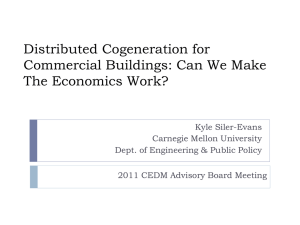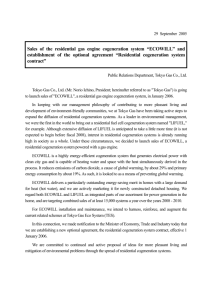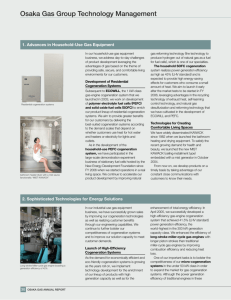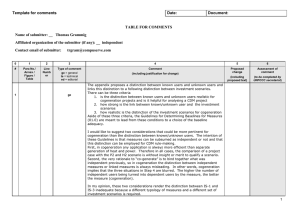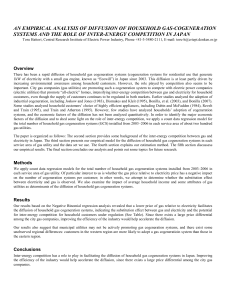MANAGEMENT DECISIONS FOR COGENERATION Robert R. Radcliffe
advertisement
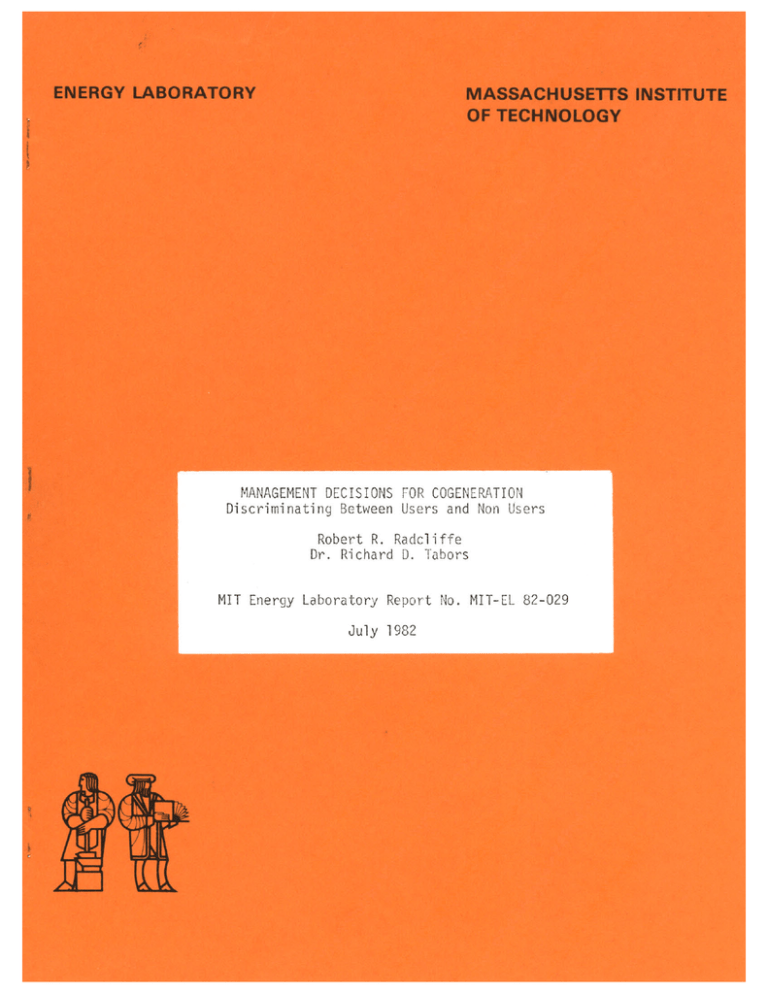
MANAGEMENT DECISIONS FOR COGENERATION Discriminating Between Users and Non Users Robert R. Radcliffe Dr. Richard D. Tabors MIT Energy Laboratory Report No. MIT-EL 82-029 July 1982 Chapter I 1.1 Introduction The previous study of this series, Management Decisions for Cogeneration, confirmed that a number of non economic/ financial factors did play a part in the decision by facility owners to invest in cogeneration technology. These factors include: Uncertainty caused by regulatory action; Desire for energy self sufficiency by an organization; Financial flexibility; Experience with electricity cogeneration or self generation; Capital budget planning methods. The factor analysis method used for data analysis defines surrogate variables which have maximum generalizability to the universe of potential variables. The ranking of factors explains the variance in total sample responses from most variance explained to least. Finally, the survey results allowed a step by step evaluation of the estimated maximum potential for cogeneration retrofit in this utility service territory. 1.2 Measurement Goals In completing the initial analysis of M!anagement Decisions for Cogenerction, one question stood out. How do you predict if a particular facility is a good prospect for adoption of cogeneration technology? Two methods may be used to answer this question: multinomial logit and discriminant analysis. Discriminant analysis was chosen. 1.3 Research Design The research design for this study is a two-step procedure involving a mailed questionnaire and a follow-up telephone call or personal visit. The population of respondents is commercial and industrial customer accounts which achieved a monthly KW demand level of 750 KW in any one month of 1981 in a particular service territory. We obtained a list of the population from Boston Edison Company, an electric utility servicing the Boston area. Each potential respondent's organization received a telephone call to identify the correct individual's name and address to assure the questionnaire went to the proper individual. In approximately 3 cases in 10, M.I.T. Energy Laboratory staff were able to talk directly to the individual who would complete the questionnaire and encourage that person to cooperate. In this initial stage four potential respondents refused to participate. The questionnaire was mailed April I and a follow-up card was mailed to all non-respondents on April 15. Selective telephone calls on incomplete responses were made up to May 30. To pursue further other issues raised in conversations with respondents, a telephone interview or site visit took place with a selected group of respondents. 3 We,received a total of 170 responses to questionnaires. Forty one of the respondents refused to answer the questions on the grounds that cogeneration was not relevant at the facility in question or that the organization had no interest in cogeneration. This left 129 usable responses or 32.2 percent response rate. Tests of proportion between respondent group and total population indicated no statistically significant differences in responses by organization ownership, function, individual contacted, or electrical energy demand. 4 CHAPTER 2 Cogeneration Technology Investment 2.1 Forecasts of cogeneration potential Since 1975, the Federal government, state governments, a number of electric utilities, and a few private organizations studied the issue of cogeneration of electricity and steam. The strongest statement one can make about these studies is that they are diverse, and usually overstate the potential for cogeneration. "Most studies look at cogeneration from the perspective of the firm." Pickel (1982, p. I-15) notes, "As studies are more specific geographically, they tend to be an enumeration of potential sites for cogeneration. Forecasts of cogeneration based on enumeration of sites commonly have lower estimates of cogeneration potential than studies estimated from energy use figures. Most studies limit themselves to restrictive assumptions about sizing of plant, fuel and electric prices and characteristic cogeneration plant types." Pickel cites these restrictive assumptions about plant size and operations as a main reason for the overestimation of cogeneration potential. Of the national level forecasts of cogeneration commonly referred to in the literature, Joskow (1981, p. 26) notes the "estimated economic potential for cogeneration varies quite widely among the studies. Estimated energy saving associated with cogeneration vary by an order of magnitude. Estimates of additional electricity production and equivalent ----------- ~-- liI Illlmimliii base-load generating capacity vary by more than an order of magnitude." The conclusions of these five and other studies need to be stressed. 1) 6 With the exception of Thermo Electron(197 ), all studies either conclude or assume steam turbine cogeneration systems using coal are the most economical choice. 2) Diesel and gas turbine systems are not as economical as coal fired steam turbine systems. 3) Oil fired steam turbine systems are less economic than coal fired but more economic than diesel or gas turbines (at least in the Northeast). (Pickel, 1982) We concluded from our previous study that non-economic variables are clearly important in the decision process. These non-economic "factors" inferred from the analysis generally correspond to strategic and long range planning aspects of the capital budget process discussed in the literature. Strategic factors for an organization include: Self Sufficiency Present Cogenerator Conservation Objectives Joint Ventures Policy Long range planning or capital budgeting factors for an organization include: Cost Uncertainty Due to Regulations Utility Price Constraints Human Relations Timing Planning Factors Cost of Capital 6 In seeking to identify which variables are most important in the decision process, factor analysis provided the opportunity to infer a rank ordering of factors from those which explain most variance to those which explain least variance. As a crude approximation, the factor order is a measure of the "importance" of each factor in the special and limited sense that they successively explain smaller and smaller amounts of total variance common to all variables in the set. However, the reader is cautioned that data for this study comprised a small group of respondents and the variables analyzed are ordinal in scale. Further, the factor analysis solution provides no measure of importance in terms of the effect each factor has on the decision to adopt or not adopt cogeneration. To determine which variables seperate the cogenerators from non-cogenerators, we use discriminant analysis. *mIuIIIIIJ" CHAPTER 3 Analysis Method Cogeneration decision variables 3.1 There are five key types of interrelated information needed to evaluate the effect of decision variables on use of cogeneration. Within these five areas, this study developed a set of variables which measure attitudinal responses from individuals who manage a facility, descriptive variables which measure behavior and physical conditions, and variables which measure potential choice. These five types of questions cover identification variables, strategic planning, long range planning and operational planning issues, and physical plant characteristics. Within the area of long range planning, the research explores two important subsets of information. First, the study determines the method of calculating the worth of a cogeneration investment including the calculation methodologies and discount rates used. Second, it evaluates perceptions of factors which might increase risk to a firm and therefore increase cost. Within the areas of operation planning the study evaluates two important aspects of the problem. First, the method a company uses to engage in manager performance evaluation will heavily influence the managers planning of long term capital improvements. Second, the degree of efficiency in physical plant operation may heavily influence the decision to cogenerate. 3.1.1 Identification There are seven variables used to develop descriptive information on each respondent. This identification information is used to classify respondents and to identify differences in response between organizations. Variables include: organization type SIC classifcation organization function facility use electricity account number area served square feet facility ownership, lease, or rental VAROOl VAROO02 VARO03 VAROO04 VAR005 VARO06 VAROO07 - 3.1.2 Strategic Planning Anthony (cited in Lorange, 1972, p. 4) states that strategic planning is "the processes of deciding on objectives of the organization, on changes in these objectives, on the resources used to obtain these objectives and on the policies that are to govern the acquisition, use, and disposition of these sources. The taxonomy of strategic planning commonly used today is slightly less encompassing. This study differentiates strategic planning from long range planning on the basis that strategic planning provides a sense of direction about the company and policies for evaluation while long range planning sets out realistic capital budgets to achieve those policies. There are a number of strategic issues related to energy use at a facility. These strategic issues for cogeneration include two ~~---"II -~^IYIY IIIIIIIIIIiliYI YYIIYIYIYIYIIII dimensions of energy policy (energy conservation and fuel switching) and policy on joint ventures for energy projects. Variables include: VARO10 VAROll VAROl2 VARO03 VARO14 VAR015 VAR016 VAR017 VAR018 VAR019 VAR035 VAR036 VAR037 VARO038 - Energy independence Energy independence from utility Energy efficiency Reduce oil imports Joint funding energy projects Joint funding with utility Joint funding with utilty impossible Energy conservation projects low priority Availability of financing prohibits cogeneration Economy limits cogeneration Regulation as utility Good utility relations limit cogeneration Cogeneration viable investment Scarce oil use vs. savings 3.1.3 Long Range Planning Long range planning, management control (Lorange, 1972) and capital budgeting (Clark, 1979) are different names for the second stage of an organization's planning process. Given.the goals and policy laid out in the strategic planning process, how does management implement these goals. "The components of capital budgeting analysis involve a forecast of the benefits and costs of a project, discounting the funds invested in a project at an appropriate rate, assessing the risk associated with the project, and follow up to determine if the project is performing as expected" (Clark, 1979, p. 4). There are three main groups of questions related to long range planning for cogeneration. These questions include financial issues, timing of investment, and uncertainty about regulation. In many cases IImmmE 10 these issues interrelate so that the effect of perceptions about one issue provides input into the solution of a second issue. For example, a firm may determine a project hurdle rate, a minimum rate of return which a project must exceed to be funded. The perception that delay due to the air quality regulation approval process increases risk may be (incorrectly) evaluated by adding an interest rate premium to the hurdle rate. Similarly, the issue of timing may prove to be significant in conjunction with the discount rate. A short planning horizon is usually associated with a high discount rate and an emphasis on short term returns. Such an emphasis on the short term works to the detriment of capital improvements because investment characteristically reduces return on investment in the early years of a project. Variables include: Finance issues VARO18 - Financing prohibits cogeneration VAR021 - Primary caiulation method VAR022 - Second calculation method VAR023 - Third calculation method VAR024 - Discount (interest) rate VAR025 - Interest rate premium VAR026 - Capital budget limits Finance issues relating to cogeneration fall into two broad categories. First, does the plant manager or engineer perceive capital as a limited item. In budgetary systems, there are usually administratively imposed limits on capital budget items. The relative perception on the part of engineer or manager of capital budget limits ---- IIIIIIIIIIIIIIIYYIIIYII IIIYYIIIIII may artificially restrict investment by ruling out in advance consideration of a captial intensive investment. The second issue of finance for cogeneration is whether the investment is "properly" valued. Two problems characteristically arise in evaluation of capital items. 1) Which calculation method is appropriate for evaluating the worth of a project 2) What rate of interest should be charged for use of funds The calculation method used plays a role in acceptance or rejection of a capital budget item because the calculation method itself may bias results. A total of eight methods are specified in the study. The question is open ended, allowing respondents the option of entering a different method. Further, the methods are rank ordered for priority of calculation method by the respondents. The calculation methods included in the study are listed in Figure 3.1 below and categorized by type. Figure 3.1 CALCULATION METHODS Judgement Experience and Judgement of Managers Accounting Accounting Rate of Return Return on Investment Index Payback Profitability Index Cash Flow Net Present Value Internal Rate of Return Annual Capital Charge 12 Judgement of managers or engineers is the primary starting point for any evaluation of captial budget items. Yet it may represent the end of cogeneration consideration in many companies. While not a caluculation method per se, it is an essential issue in the evaluation and is therefore included here. Accounting based evaluation measures are fairly common in U.S. industry. Two accounting based methods used in evaluating capital budget items are accounting rate of return and return on investment. Accounting rate of return compares annual net income, including depreciation, to the investment. Using either of two common methods (gross investment method or one half of the gross investment) the accounting rate of return calculation method is consistently incorrect because it ignores the time value of money (Anthony and Reese, 1979). Return on Investment (ROI) is a similar problem but for different reasons. ROI is an accounting calculation of a rate of return on the company's debt and equity which constitutes a one year picture of how well a company uses its invested capital. This calculation yields a percentage return which any capital project is expected to exceed to be accepted. Again, the problems with Accounting based evaluation methods are that they include no allowance for the time value of money and are dependent upon accrual accounting techniques (Clark, 1979). Two index methods are included. These are payback and profitability index. Payback is a simple comparison of annual savings to investment cost. The resultant index number is the number of years to pay back the investment. While the time value of money may be accounted for with a discounted payback method, the primary use of NWII IIll4lllll, ,,I111 ." 13 payback is comparison of the number of years to payback of each Problems with this method usually come from ignoring what project. happens to cash flow after the investment is paid back. In comparison of payback periods, companies which desire liquidity or operate in a rapidly changing industry may choose high return or low payback items. Since cogeneration is a long lived investment with uncertain annual revenue, use of payback might seriously jeopardise its selection. The second index method, profitibabity index, or Benefit Cost Ratio, is a calculation of the present value of cash flows divided by the investment. This method has a number of problems if used to compare two mutually exclusive projects such as cogeneration versus steam boiler and electric purchase. Primarily, the profitability index does not take into account the relative size of a project's Net Present Value or correctly differentiate between projects which are not mutually exclusive. While some special investment cases do exist where profitability index is the preferred method of calculation, for cogeneration systems it is not preferable to Net Present Value. (Brealey and Myers, 1981) Finally, there are the methods preferred by finance experts for calculation for capital investment which take into account the time value of money. The three methods included as options in this study are Net Present Value, Internal Rate of Return, and Annual Capital Charge. Internal Rate of Return (IRR) is defined as that discount rate which makes the Net Present Value of a project exactly equal to zero. The calculated IRR is then compared to a prespecified hurdle 14 rate. If the calculated IRR is greater than the hurdle rate, accept the project. In the case of a relatively simple investment opportunity, IRR is satisfactory. IRR is very widely used in industry as a means of evaluating investment opportunities. However, it should not be used to evaluate cogeneration for two reasons. First, IRR gives misleading results in cases where a company compares two mutually exclusive projects. Second, as is likely with cogeneration plants, IRR will give multiple "correct" answers if the sign of the cash revenues changes during the life of the project. Therefore, if cash flows are negative in one year, IRR will be inaccurate (Brealey and Myers, 1981). Net Present Value is one of the two calculation methods preferred by finance experts for cogeneration project evaluation. It consists of a comparison of the present value of a stream of cash inflows and outflows discounted from future years to the present. This present value of cash flows is compared to investment to yield net present value. If Net Present Value is positive, the project should be accepted (Brealey and Myers, 1981). Finally, annual capital charge is a method which involves discounting all cash inflows and outflows to present value and determining the equivalent annual charge over the life of a project. This method is especially useful for evaluating expenditure alternatives that are not profit producing. (Clark, 1979) One further aspect of the calculation for cogeneration investment needs to be mentioned. For those methods which use a discounted cash flow evaluation, the level at which the discount rate is set is an important determinant of the cost effectiveness of an investment. Two WMINI issues are important in evaluating the discount rate or cost of capital used. First, there is some theoretically optimum cost of capital which is a function of the risk of the asset. This risk applied to the asset may be different from the risk applied to Arguably, therefore, borrowing of funds by the company as a whole. the cost of capital for the company may be different from the cost of' capital for a cogeneration system. This in fact is the argument used by Pickel (1982) for selection of a 5 percent real rate of interest as the discount rate to be used across all firms. To make a rough calculation of a discount rate for firms operating a cogeneration system it is necessary to use the capital asset pricing model (CAPM). CAPM argues that the cost of capital for a firm is a function of the risk free rate of interest plus some coefficient Beta times the risk premium of the market. F = rf+ B(rm - rf) where: r = risk of firm rf = risk free rate of interest B = measure of market risk (rm-rf) = risk premium on market Using the average asset B for electric utility industry assets of 0.41 and the thirty year average risk premium on the market of 8.8 percent (Brealey and Myers, 1981),.a rough calculation of project asset B for a cogeneration project can be made. The risk free 16 rate is the present U.S. Treasury bill rate for 20 year notes which is approximately 13.8 percent (Wall Street Journal, June 9, 1982, p. 52). r = 13.8 + .41(8.8) = 13.8 + 3.608 = 17.408 We should expect discount rates for use in discounted cash flow calculations to be in the vicinity of 17.5 percent. Timing VAR019 VAR020 VAR054 issues - Economy limits cogeneration - Planning horizon - Years to retirement Timing issues are considered in one of three ways. First, the effect of general economic conditions on capital budget decisions is considered in variable 19. Second, the planning horizon commonly used for energy conservation capital improvements provides a fair indication of the willingness of an organization to plan long term investments. Third, the years to retirement of the main heating plant gives an indication of the planning window for selection of a cogeneration plant. Uncertainty issues VAR030 - Changing air quality regulations VAR032 - Changes in air quality regulations will cause expense VAR033 - Electricity production for own use VAR034 - Electric sale price limits cogeneration VAR035 - Regulation as a utility VAR039 - Backup charges prevent cogeneration YIV 17 VARQ40 - PURPA Awareness VAR041 - Cogeneration policy change due to PURPA Uncertainty issues revolve around either the relationship between the organization which desires to cogenerate and the electric utility or between the potential cogenerator and government regulations. One added element of uncertainty in the price picture for cogeneration, and therefore for planning cogeneration systems, is the effect of the Public Utility Regulatory Policies Act (PURPA). This act is Title II of the National Energy Act of 1978 and contains two sections which directly affect the potential cost-effectiveness of cogeneration systems. Section 201 of PURPA specifies two general criteria for a cogeneration facility. Cogeneration facilities are exempted from incremental pricing provisions of Title II of the Natural Gas Policy Act. This provision requires that interstate gas used in large industrial boilers be subject to incremental pricing. In essence, incremental pricing means that as consumption of natural gas increases, the price paid per unit of consumption increases. By voiding this provision for cogenerators, use of natural gas as a combustion fuel is less expensive. One point must be made clear. Under the provisions of the Fuel Use Act, oil and natural gas may not be used in new burners above 100 million Btu or total burner capacity of 250 million Btu. This provision effectively limits new burner fuels to coal or coal-derived fuels. While exemptions on use of oil and natural gas under provisions of the Fuel Use Act may be obtained to satisfy air quality regulations, the Act still poses a limitation 18 to cogenerators using diesel or gas turbine technology. No clear public policy has emerged on this issue of oil or natural gas use in new equipment designed to cogenerate and technically the prohibitions of the Fuel Use Act still remain in place (Demakos, 1976). Section 210 of PURPA provides guidelines for state Public Utility Commissions to use to develop state-level regulation of cogeneration and small power production facilities. Electric utilities are bound under these rules to purchase electricity offered for sale by the cogenerator at prices equal to full avoided costs. The electric utility must pay a price equal to avoided energy cost of producing a kilowatt hour of electricity plus some amount of avoided capacity cost. While different public utility commissions handle calculation of avoided energy cost and avoided capacity costs in different and occasionally unique ways, the effect of PURPA Section 210 has been to significantly increase the revenue potential of electrical cogeneration compared to conditions prior to PURPA (Bottaro and Radcliffe, 1982). There are two major drawbacks to easy application of PURPA Section 210. First, in 1980, the state of Mississippi challenged the constitutionality of PURPA Section 210. The Federal District Court in Jackson overturned the provisions of Section 210 and held the law unconstitutional. While the appeal process is just completed with the federal law upheld by the U.S. Supreme Court in its decision of June 1, 1982, federal initiatives in this area were stymied for a long time (Energy Users News, June 10, 1982). However, in the utility 19 service territory of all respondents to this survey, the provisions of PURPA or of legislation similar to PURPA but enacted at the state level are in place or considered a strong possibility by both utility and regulators alike (Massachusetts, 1982, House Bill No., 85). Second, Bottaro (1982, p. 2) states, "the validity of these [PURPAJ rules has been cast into doubt by the U.S. Court of Appeals (D.C. Circuit) in A.E.P. V. FERC (January 22, 1982) which invalidated the FERC rules regarding the requirement that rates must equal avoided costs and the requirement that utilities must interconnect with qualified facilities. The matter is currently (April 1982) under appeal." Besides PURPA and the Fuel Use Act (FUA), potential cogenerators need to consider the Clean Air Act and Clean Water Act regulations. The Clean Air Act has two significant elements of importance to cogenerators. First, each state is required to develop and submit to the Federal Environmental Protection Agency a State Implementation Plan (SIP) which divides the state into Air Quality Control Regions (AQCR) for particulates and sulphur dioxide (SO2 ) emissions (Demakos, 1980, p. 21). Once a state has air quality control regions, they must be classified as Class I, (pristine) Class II (moderate air quality deterioration permitted) or Class III (air quality may deteriorate to National Ambient Air Quality Standards levels). Where air is cleaner than ambient standards Prevention of Significant Deterioration (PSD) regulations are in effect. Since PSD rules apply to any areas designed as "attainment" for any one pollutant and almost 20 all AQCR are in attainment of at least one pollutnat, PSD will affect almost all potential cogenerators. If PSD is required, major stationary sources whose average combined input energy is 250 million Btu per hour for all burners must use best available control technology (Demakos, 1980). Similarly, if a source of effluent falls under the new source performance standards (NSPS) of the Clean Water Act it must achieve similar stringent standards, "the greatest effluence reduction achievable through the use of the best available demonstrated control technology (Demakos, 1980, p. 50). In the face of ill defined, conflicting and sometimes obscure regulations, confusion among potential users of cogeneration is likely to occur. 3.1.4 Operational Planning Operational planning, operational control, tactical planning, and operating budget planning, are synonymous terms to define "the process of measuring that specific tasks are carried out efficiently and effectively" (Lorange, 1972, p. 4). The operation planning elements of the survey look at two types of information. First, there are a number of questions which measure perceived limits of cogeneration systems or operating objectives. The second group of questions comprises the final one half of the survey. These questions evaluate physical characteristics of the facility and establish operational conditions. .1Y IWIi1I*IYIYIYIiII1h, Variables include: 0 erational VARi27 - Personnel limits cogeneration VAR028 - Make up water supply limits cogeneration VAR033 - Electric production for our own use Physical VARU4TITo VAR047 - Load diversity for a 24 hour period in four hour blocks VAR048 - Present cogenerator VAR049 - Proportion KWH cogenerated VAR5OO - Proportion KW cogenerated VAR051 - Heating plant type VAR052 - Heating fuel VAR053 - Previous heating fuel VAR055 - Cooling plant VAR056 - Percent high pressure steam VAR057 - Percent low pressure steam VAR058 - Percent hot water VAR059 to VAR075 - Energy conservation activities commonly available for commercial and industrial buildings VAR076 - Heating fuel reduction since 1972 VAR077 - Electric energy reduction since 1972 Operational questions garner information about operating protocols or perceived limits to operations. Two policy questions look at production levels of electricity while two other questions focus on operating limitations of personnel or make up water. The second group of variables may be broken into three subgroups. These are physical plant operating characterstics, physical plant description, and energy conservation activities. Physical plant operating characteristics include load diversity, steam load and hot water load. Physical plant description includes heating and cooling plant type and fuel switching in previous years. Finally, energy conservation includes the type of conservation activity accomplished and amount of energy saved since 1972. 3.1;5 Energy Use The most important factor in consideration of traditional cogeneration systems is process energy use. However, signficant evidence exists to argue that systems may now be designed to be electric load following. With PURPA regulations, the ability to sell excess power to the electric utility provides the opportunity to take advantage of electric load following cogeneration to use greater electricity production from any cogeneration capacity. Energy use figures for each type of fuel consumed in the facility, including KW demand, and the proportion of energy used for process, is the final segment of the study. These energy use questions are used to calculate an additional variable for million Btu of thermal energy. These energy use figures are then normalized for size of facility by dividing the energy use by VAR008, square feet, thus yielding a calculated million BTU per square foot figure used in the discriminant analysis. Hours is a variable calculated from six seperate variables, VAR042 to VAR047. This variable represents an estimate of the number of hours per year a facility operates at fully loaded conditions, at partially loaded conditions, and at low load conditions. Load in this case refers to occupancy. The weekly schedule is converted to a percent of load figure and multiplied by the number of weeks per year to arrive at an estimate of annual load. 3.2 Discriminant Analysis method Discriminant analysis begins with a desire to distinguish statistically between two or more groups of cases. "The mathematical objective of discriminant analysis is to weight and linearly combine the discriminating variables in some fashion so that the groups are forced to be as statistically distinct as possible." These "discriminant functions" are of the form Di = dilZ l + di2Z 2 + ... + dipZ p Where: Di = Score on discriminant function i di = Weighting coefficient Z = Standard values of the p discriminating variables The discriminant function is useful in two ways. These two uses are analysis and classification of cases. "The analysis aspects of this technique provide several tools for the interpretation of data. Since the discriminant functions can be thought of as the axes of a geometric space, they can be used to study the spatial relationships among the groups. More importantly, the weighting coefficients can be interpreted much as in multiple regression or factor analysis. In this This material is adapted from Nie et al. (1975). 24 respects they serve to identify the variables which contribute most to differentiation along the respective dimension (function)." (Nie et al. 1975 pp.435) The use of discriminant analysis as a classification technique comes after the initial computation. Once a set of variables is found which provides satisfactory discrimination for cases with known group memberships, a set of classification functions can be derived which will permit the classification of new cases with unknown memberships. To check on the adequacy of the original discriminant functions, ;ve classify the original set of cases to see how many are correctly classified by the variables being used. The procedure for classification involves the production of a probability of membership in the respective group, and each case is assigned to the group with the highest probibility. "The traditional classification equations are derived from the pooled within-groups covariance matrix and the centroids of the discriminating variables. The resulting classification coefficients are to be multiplied by the raw variable values, summed together and added onto a constant" (Nie et al. 1975 p.4 36 ). The equation for one group would appear as Ci = cilV 1 + ci2V 2 + ... +cipV p + CiO Where : Ci = Classification score for group i ci= Classification coefficients cio= Constant V = Raw score on the discriminating variable 25 The rule of assigning a case to the group with the highest score is then equivalent to assigning the case to the group for which it has the greatest probability of membership. This study uses a stepwise procedure to develop the discriminant function. The stepwise procedure begins by selecting the single best discriminating variable according to the overall multivariate F ratio for the test of differences between group centroids. A second discriminating variable is selected as the variable best able to improve the value of the discrimination criterion in combination with the first variable. At each step, variables already selected may be removed if they are found to reduce discrimination when combined with more recently selected variables. The use of a stepwise procedure results in an optimal set of variables being selected. The canonical correlation tells how closely the function and the group variable are related, which is just another measure of the function's ability to discriminate among groups. The canonical correlation squared is the proportion of variance in the discriminant function explained by the groups. A second criterion for eliminating discriminant functions is to test for the statistical significance of discriminating information not already accounted for by the earlier functions. As each function is derived, starting with no (zero) functions, Wilk's lambda is computed. Lambda is an inverse measure of the discriminating power in the original variables which has not yet been removed by the disciminant functions - the larger lambda is , the less information 26 remaining. The variable which maximizes the F ratio also minimizes Wilk's Lambda, a measure of group discrimination. This test takes into consideration the differences between all the centroids and the cohesion or homogeneity within groups. The standardized discriminant function coefficients are of great analytic importance and correspond to the d j's given in the formula above. Any single score represents the number of standard deviations that case is away from the mean for all cases on the given discriminant function. By averaging the scores for the cases within a particular group we arrive at the group mean of the respective function. For a single group, the means on all the functions are referred to as the group centroid, which is the most typical location of a case from that group. A comparison of the group means on each function tells us how far apart the groups are on that dimension. When the sign is ignored each coefficient represents the relative contribution of its associated variable to that function. The sign denotes whether the variable makes a positive or negative contribution. I ~niIImIIIIIYIImhhIYIIII CHAPTER 4 Results of Discriminant analysis 4.1 Selection of Variables for Analysis From the 92 possible variables in the survey we selected a subset of 42 variables for discriminant analysis. These variables included square feet of floor space, all questions related to organization policy, hours of operation for the facility, and energy use. 4.2 Selection of Variables to Enter Solution Eleven variables entered the stepwise discriminant analysis solution and remained after testing for significance. Table 4.1 lists the discriminating variables and their short labels. Table 4.1 VARIABLES ENTERING DISCRIMINANT FUNCTION STEP 1 Hours 2 VAR037 3 VAR013 4 VAR038 5 VAR034 6 VAR027 7 VAR080 8 VAR036 9 VAR015 10MBSQ 11VAR032 LABEL Hours of operation per year Viable investment this facility Reduce oil imports Scarce oil versus energy savings Electric sale price limits cogeneration Personnel limits Electric demand peak month KW Good utility relations limit Joint funding - utility Million BTU per square foot Air quality regulations : expense The order in which variables enter the discriminant function is not an indication of the importance of the function. The 'importance of 28 a variable in explaining a discriminant function is determined by the canonical discriminant function coefficients. Table 4.2 contains these coefficients. The size and direction of the coefficient is a significant indicator of the importance of each of the variables in the decision to use cogeneration. We divide the variables into two groups: policy and physical variables. Table 4.2 CANONICAL DISCRIMINANT FUNCTION COEFFICIENTS VARIABLE NAME COEFFICIENT VARO3 Reduce oil imports -0.23687 VAR015 Joint funding - utility -0.42626 VAR027 Personnel limits -0.47901 VAR032 Air quality regulations : expense 0.32050 VAR034 Economy limits cogeneration 0.48813 VARO36 Good utility relations limit 0.34-002 VAR037 Viable investment this facility 0.48272 VARO38 Scarce oil versus savings -0.50754 HOURS Hours of operation per year -0.67483 VAR080 Electric demand peak month KW 0.46693 MBSQ Million BTU per square foot 0.35741 Policy variables fall into one of two types, strategic or operational. Strategic questions include variables 13, 15, 36, 37, and 29 38. The questions for each of these variables are included in Appendix A. Variable 13 argues that even if cogeneration were cost effective, the organization would not invest because*it would require increased consumption of scarce oil. The relatively low and negative coefficient indicates the differences were not great, but cogenerators would tend to disagree with the argument of the question. Variable 15 argues the organization, if it were to cogenerate, would do so only if the utility were a joint partner. Again, existing cogenerators differed from non cogenerators in being much less interested in joint cogeneration projects. Variable 36 argues the organization would not cogenerate because it might risk good relations with the electric utility. The positive coefficient of 0.34 indicates some positive but not very strong differences from non-cogenerators. Variable 37 asks if the respondent believes cogeneration to be viable at the facility in question. A positive coefficient of 0.48 indicates differences in the right direction and of substantial size between the two groups. Variable 38 argues oil fired cogeneration would not be used even if cost effective because it would increase use of imported oil. The strong negative response indicates cogenerators would not follow that line of reasoning. Three variables consider operational issues of a cogeneration system. As is to be expected, cogenerators did not consider personnel to limit their ability to cogenerate (VAR027) and the strong negtive coefficient bears this out. However, variable 34 has a strong positive difference (coefficient of 0.48) between the two groups. Similarly, there is a small positive difference between the two groups over the 30 issue of air quality regulations causing unexpected expense. Finally, three physical variables are used in the analysis. KW demand is measured directly from responses to question 52. However, two other variables have been calculated. Hours is an estimate of the number of hours per year a facility will operate. It is based on question number 38 of the survey. Hours is calculated by estimating a percentage use figure for each four hour period of a typical work week and multiplying by 52 weeks per year. MBSQ is calculated by converting all energy use in a facility to millions of British Thermal Units and dividing by the number of square feet in the facility. Both variable 80 and MBSQ have a positive relationship while the strongestdiscriminating variable HOURS has a negative relationship between groups. To check on the quality of the discriminant function developed in the analysis section, each case was classified according to their variables as members of either group 1; cogenerators or group 2; non-cogenerators. One case was originally unclassified. Table 4.3 indicates the results of the classification. Table 4.3 PREDICTED GROUP MEMBERSHIP ACTUAL 1 2 Ungrouped NO. OF CASES 5 III 1 PREDICTED GROUP 1 2 4 2 7 104 1 0 Percent of "grouped" cases correctly classified : 93.10 31 CHAPTER 5 Conclusions A number of points need to be made about this survey, the response rate, and use of the survey responses in discriminant analysis. Of the 399 organizations in the population, the usable number of responses, based on electric utility account numbers, was 129 or 32.2 percent. Because of multiple account numbers at a facility, only 117 responses for seperate facilities were included in the discriminant analysis., Further, only 5 of the 117 respondents are cogenerators. This small group of cogenerators means the discriminant function developed is not robust. Thus, while the analysis is valid for this particular electric utility and the process appears to be very encouraging as an analytical method, the reader is cautioned not to extrapolate the discriminant function which resulted from this analysis to other electric utility territories. Without prior evidence of customer similarity and similar utility environments. The discriminant analysis provided a set of general conclusions for the service territory evaluated in this study which can be extrapolated with caution to other areas. - The potential for cogeneration in older urban areas with minimal high energy density industries is not great. In Boston, there were only 8 additional firms identified whose characteristics matched 32 those of cogenerators already in the region. Of these at least three would be eliminated because of knowledge of the specifics of their energy loads -- essentially all electric facilities -- which on other grounds would make them unlikely cogenerators. - The generic types of industries and commercial/ industrial facilities most likely to cogenerate are those with relatively high use factors at the facility. This brings in hospitals and specific large commercial facilities such as hotels and conference centers. - The specific variables which are considered by industrial and commercial/ institutional facilities in their decision to cogenerate appear from this study NOT to be those which the utility can influence positively by any method other than provision of information. This last conclusion is most likely generalizable beyond the territory studied. The utility can assist,can act as consultant, could provide easy access to fuels (coal for example) and can provide technical .information. It does not appear that actions of the utility directly influence cogenerator decisions.
